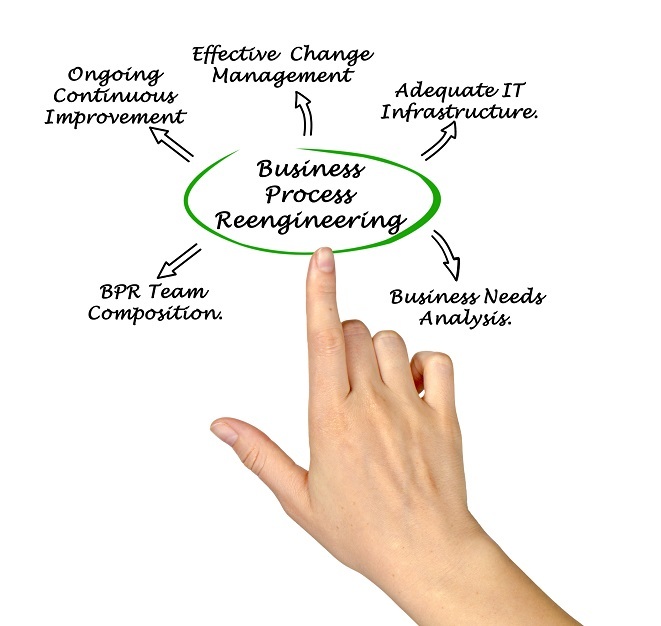
 Data Structure
Data Structure Networking
Networking RDBMS
RDBMS Operating System
Operating System Java
Java MS Excel
MS Excel iOS
iOS HTML
HTML CSS
CSS Android
Android Python
Python C Programming
C Programming C++
C++ C#
C# MongoDB
MongoDB MySQL
MySQL Javascript
Javascript PHP
PHPPhysics
Chemistry
Biology
Mathematics
English
Economics
Psychology
Social Studies
Fashion Studies
Legal Studies
- Selected Reading
- UPSC IAS Exams Notes
- Developer's Best Practices
- Questions and Answers
- Effective Resume Writing
- HR Interview Questions
- Computer Glossary
- Who is Who
Difference between Business Process Management and Business Process Reengineering
Introduction
Business process improvement is the constant effort of every organization alike. Process improvement leads to better efficacy and success. There are many management concepts developed and remodeled with a view to achieve optimal business outcome.
Two such concepts related to boosting performance are Business Process Management (BPM) and Business Process Reengineering (BPR). Though both BPM and BPR facilitate business improvement, they are significantly different from each other. The various characteristics that distinguish BPM from BPR are detailed here.

Business Process Management vs. Business Process Reengineering
A group of activities that help to achieve a business goal is termed as business process. BPM is a management approach that is used to get the tasks done and increase value through engaging tools and techniques to manage the business process. BPR on the other hand refers to the complete revamp and redesigning of the existing processes to attain a drastic increase in business outcome.
Conceptual Differences
BPM − This is a wide management discipline that governs the functional roles, duties, laws, vision and goals, incentives and business strategies. A broad scope of methodologies and tools has evolved around managing processes including Six Sigma, lean management for continuous improvement and Agile or iterative system for competitive advantage.
BPR − Business process reengineering is all about bringing a radical change in the business process as a whole to achieve a quantum jump in organizational outcome. Information Technology serves as a key ingredient in redesigning the process with IT enabled process maps, flow charts and automation of repeated tasks.
Objectives
BPM
Improving customer satisfaction and business value.
Facilitates constant improvement and agility.
Motivates employees towards achieving business goals as a result of process management systems.
Business processes are standardised reducing the risk of human error.
Simplifies and streamlines operational activities for boosting business.
BPR
Plan for a radical change by aligning business objectives with customer preferences and market trends.
Identify and redesign major processes with the help of information technology.
Revamp major process units to attain cost reduction and cycle time thereby improving quality.
Reorganize the structure, role, responsibility and accountability of the people involved to optimize process functions.
Ensure a dramatic leap in return of investment as a result of BPR.
Plan of Action
BPM
Design − The first step of process management is to gain clarity on process design. Existing process and job rules are analysed and inputs taken from stakeholders and management. The aim of this step is to make sure that the process flows in conjunction with the overall organizational goals.
Model − The second step is to chalk out a model to compliment the current business operations by identifying and defining process enhancements where ever needed.
Execute − A pilot test is conducted at this step where the new process are put to test with a small group of stake holders before it goes for a full fledged roll out. Automated processes are also put to test in this phase.
Monitor − Performance indicators are put in place for measuring the actual performance against the scorecards. Performance from each individual units and as a whole need to be monitored with measurement yard sticks to find flaws if any.
Optimize − After capturing the defects on execution through monitoring performance, the process can be effectively optimized. It improves and reinforces each process units towards the business goals.
BPR
Identifying Information − Gathering and identifying information on the existing business process is crucial in a BPR activity. This has to start prior to the initiation of reengineering efforts.
Analyse data − An in depth knowledge in the current process will help the BPR team to identify problematic areas that require redesign. The root cause for flaws in business process is isolated here through analysis.
Plan alternatives − Once the root cause is identified alternate solutions to overcome the issue can be developed. Information technology is applied to facilitate strategic transformation plans for process redesign.
Redesigning − The most suitable design plan is selected in conjunction with business objectives from the alternatives. It should match with the time, cost and IT infrastructure allocated for the reengineering process.
Implementation − Once the new process design is accepted the same is implemented and compared with the help of performance indicators. New workflows for enhancing process functions need to be communicated to the people involved and training given for maximum optimization.
Change management − As BPR results in radical shift to the organization as a whole, there will be resistance to the changes in respect of culture, work flows, and staff layoffs. Involvement of people from the initial phase of BPR activities will help to tackle the issue of resistance and manage change more effectively.
Outcome
BPM
Gather information from functional process units for real time access, evaluation and improvement.
Data to be organised automatically as and when it is captured.
Develop technical models to enhance process units.
Managing human resources by tracking their activities and applying work rules.
Existing gaps and flaws will be easily traceable and keeps the process in control.
BPR
Achieve purpose clarity on the existing business processes and to the required change areas.
Bring a simplified, strategic and efficient business process.
Better quality and customer value
Reduced costs and cycle time
Maximum return on investment
Advantages
BPM
Being a continuous process BPM guides employees through decisions.
Prioritization and work flow is automatically carried out.
Access to process functions and control.
Facilitate forecasting and productivity
Lesser cost involved.
BPR
Drastically improve process efficiency and communication
Reduce costs and process cycle time
Quality improvement through clear process ownership
Elimination of unproductive activities and leverage advanced technology
Integration of change management for sustainability
Optimizes return on investment (ROI)
Disadvantages
BPM
Process centric approach of BPM limits chance for innovation.
Dynamic decisions cannot be taken due to the rigid work flow pattern.
Does not offer flexibility to employees to use their inputs
BPM needs the interference of process system experts to solve an issue of a tool used.
Do not offer ease of communication through networks
BPR
Not suitable for every business. It depends on the company size and resources involved.
Time consuming and expensive
Does not result in an immediate resolution, but is a long term outcome.
Resistance to the change is much higher
Error-free automations can result in job lay-offs.
Differences of BPM and BPR in a snapshot
Concept |
BPM |
BPR |
|---|---|---|
Meaning |
Business Process Management |
Business Process Reengineering |
Function |
Transformative and continuous |
Radical and abrupt change |
Implementation |
Short and smooth upgrade |
Long term and time consuming |
Change initiation |
Flexible as per requirement |
One primary process at a time |
People involved |
Process and People alike |
BPR team with expertise from each major process units, management. |
Outcome |
Improvement of business |
Can make a dramatic effect in business output |
Cultural issues |
Not much of a concern |
Can cause serious issues |
Risk involved |
Low |
High |
Lay-offs |
Does not warrant lay-offs |
Employee lay-offs are much higher as a result of process automation. |
Conclusion
To sum up, BPM is strategizing and maintaining workflow to enhance business processes whereas BPR is a complete process reconstruction to accomplish substantial increase in business outcome.

